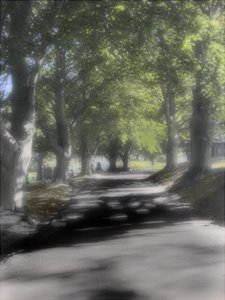
Larger image here.
I am not putting this out there as a finished work. It is a work in progress. Not this particular photo. This one is done. But towards some photos I am trying to take, photos that will be very much like this one.
Actually, it goes towards two different projects. The one, to get the light-dabbed shadows look I have in my minds eye, which is what this post is about; the other to photograph Greenwood Cemetery.
There was a painting in the old Bayou Grill in New Harmony, Indiana that got me started on this. It depicts a young priest walking through a grove of sycamore trees, the ground around him dabbed with ovals of light through the branches. What sets it apart is the nature of the light. It is not yellow, but white. Great splotches of white. Many times over the years I've tried to get that effect in a photograph but until a recent eureka moment had no idea how to go about it.
One of the most interesting things about the practice of photography is the need to understand how the brain works. So many photographic subjects appear to come out looking nothing at all like they did when we photographed them. The whitest snow, for example, is deeply saturated with blue in the photograph; our children's eyes, so clear when we snapped the photo, are invisible in deep shadow when we get the print.
The key thing to understand in those situations is that the camera is recording the information accurately. The snow really is blue and the kid's eyes really are lost in shadow.
Our brains are ultra-sophisticated versions of Photoshop. We expect to see white snow, so our brain makes it white. We expect to see a person's eyes in his face, so our brain cuts back the shadow.
Often, the trick to getting a good photo is to outsmart the brain, to see the image as the camera will see it. Once we can see light, shadow, and color as the camera sees them, then we can take the photo in such a way as to manipulate it the way our brain manipulates the original image.
Here, for example, is the original of the picture above.
Many people are appalled by the use of Photoshop these days and do not want to buy photographs that appear to have been manipulated. I agree that a lot of photographers make poor aesthetic choices in their use of Photoshop, but I only care about the finished photograph. If it is well-composed, colored, and imparts a feeling, then I don't really care if or how it was manipulated in the darkroom. In my own work I typically manipulate the image to either look like it did when I took it, or how it does when I remember it. The picture above is very close to working for me that way.
I like this photo and the one of the "typical house". Not sure which one I like better. Plus now you've got me thinking about this:
ReplyDeleteOnce we can see light, shadow, and color as the camera sees them, then we can take the photo in such a way as to manipulate it the way our brain manipulates the original image.
I'm thinking there is something similar that happens with narrative. But that's all I've got to say about it at this point other than it's pleasant to think about.
Hi Kia. Thanks. You've given me something to think about today.
ReplyDeleteIt seems counter-intuitive. The photograph and much of the thought that goes into its creation is largely scientific. Light, shadow, color, even sharpness or blur are a matter of numbers as well as aesthetics. Yet the result is a very abstract representation of reality, if it's representative of reality at all.
Narrative, on the other hand, is entirely outside the realm of science. There are, of course, rules and questions of structure, but those are entirely aesthetic customs and choices. One would think that describing a tree lined street in a cemetery would be more abstract through words than images, but that's not necessarily the case. Narrative always tells a story. An image may or may not.
Is it a street, a lane, or a road? The pavement is gray. The beech trees are gray. Intricate patterns mark their trunks. The sun casts shadows through their leaves. These shadows range from gray to black. The leaves are various shades of green, those on the ground are more often brown. The smell of honeysuckle wafts on the breeze. The sound of rustling leaves masks the noise of the nearby city.
Even with more metaphorical language, the narrative scene is more fixed than the photograph. If you look sideways, without focusing, the sun dappled shadows take forms like the shades of the dead. Are they trying to communicate? Communicate what? That they continue to exist? These ideas may be esoteric but putting them to words bring it into the material realm. The photograph remains esoteric by its silence.
Or something like that. I'll try to explore the idea further in my next post.